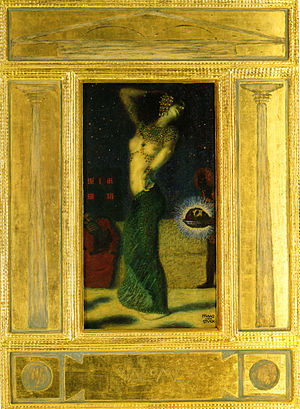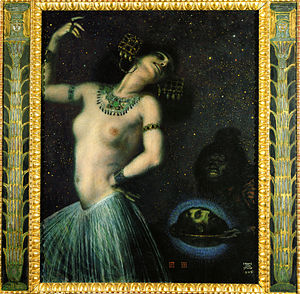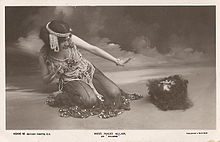Salome (Franz von Stuck)

|
| Salome |
|---|
| Franz von Stuck , 1906 |
| oil on wood |
| 45.7 x 24.7 cm |
| Privately owned |

|
| Salome |
|---|
| Franz von Stuck , 1906 |
| oil on wood |
| 115.5 × 62.5 cm |
| Municipal gallery in the Lenbachhaus |
Salome is the title of two paintings by the German painter Franz von Stuck from 1906, a third picture has been missing since the Second World War. The historical-biblical figure Salome , daughter of Herodias and granddaughter of Herod the Great , is depicted as a dancer to whom the severed head of John the Baptist is brought. Franz von Stuck was inspired, among other things, by a play by Oscar Wilde , which centered on Salome as " femme fatale ".
Stuck painted Salome in a small full portrait and a larger three-quarter portrait. The former measures 45.7 × 24.7 cm and was in the Neue Meister gallery in Dresden from 1953 to 1991 . The work was transferred back in 1991. The second, measuring 115.5 × 62.5 cm, is owned by the Städtische Galerie im Lenbachhaus in Munich and is part of the permanent exhibition there.
Image description
The main differences between the two images are the image detail, the different size and the format of the images. The earlier and smaller painting shows Salome as a full portrait, on which the dancer's bare feet and other details of the background can also be seen. The larger painting, on the other hand, shows only a section: the dancer is shown in a three-quarter portrait that begins above the knees. The upper body and face move even further into the center of the picture, while she herself was shifted a little to the left from the center of the picture.
In the center of both paintings Salome is shown as a young dancer. The woman's upper body is naked, while the neck, décolleté, hair and arms are adorned with gold jewelry with precious stones. A green skirt made of light fabric is tied around the hips, through which the contours of the hips and legs shine through. In both pictures, Salome supports his left arm on his hip. The right arm is raised in each case, whereby in the large-format picture of the horizontally stretched upper arm, the forearm stretches upwards at a 45-degree angle and the hand falls in an open gesture towards the face, while in the small-format picture the hand grasps the hair in a more natural position. In both pictures, the head is tilted back over the left shoulder so that the dancer looks to the side and shows the viewer of the chin.
In both pictures a servant is standing behind the dancer on the left. This dark-skinned figure watches Salome with his head bowed slightly and his eyes staring. He presents the severed head of John the Baptist on a gold platter , which is surrounded by a shining blue halo. This will highlight it in the picture.
The background consists of a black starry sky with shimmering gold, red and white stars. In the full portrait, the lower area is taken up by a light balustrade behind which several houses with red-lit windows can be seen, and at the very bottom by the light floor. These elements put the scene in a spatial perspective. Another person is shown in front of the parapet on the left edge of the picture. This red-clad person is Herod Antipas , who is carefully watching the dancer. Further differences in the pictures concern the details of the jewelery and the depiction of the servant.
The frames are also essential elements of the painting and were designed by Franz von Stuck. The full portrait is completely surrounded by a very wide, golden frame made up of four frame fields. On the two side parts, columns tapering upwards are shown, the capitals of which support the upper frame element with the representation of frieze and gable that is present there. Below the picture is the name “SALOME” in an area modeled on a label, as well as square ornaments with a circle on each side. The three-quarter portrait is framed with a narrow golden border and has wider frame elements on the sides, through which the actually rectangular picture forms a square surface together with the frame. On the side elements there are columns made of bundles of papyrus , which end at the top with capitals on which Medusa heads rest.
Biblical background
Herod Antipas married his sister-in-law Herodias for the second time . John the Baptist criticized this fact , which, according to the biblical story in the New Testament, led to his murder. Here are reports of events in which the name Salome does not appear, but which form the basis of the later legend of Salome. According to this, Herodias desired the death of John, but Herod refused to have him killed. On the occasion of Herod's birthday celebration, the daughter of Herodias performed a dance with which she so enraptured those present that Herod swore to her: " Whatever you ask me for, I will give it to you up to half of my kingdom." The girl asked her mother what she should want, and she whispered her own desire. She should ask for John's head. Then Herod Antipas "had made an oath in front of all the guests, he would not reject her request." . He had Johannes beheaded and his head brought to the dancer on a bowl.
Origin and interpretation
inspiration
The inspiration for the representation of Salome came from the figure of the femme fatale, popular around the turn of the 20th century, based on biblical models. It was a repeated motif in music as well as in literature and the art of the time. The novel Against the Line by the poet Joris-Karl Huysmans, whose description of Salome was the inspiration for light clothing , may have had a significant influence :
- Her bosom heaves, and at the touch of the necklace that swirls in a circle, the breasts rise. The diamonds glitter on the young skin. Her bracelets, her belt, her rings cast bright sparks.

The opera Salome by Richard Strauss, premiered in 1905, and the drama Salome by Oscar Wilde had a decisive influence on Franz von Stuck and other artists of the time. Above all, Wildes Schauspiel, in which, just as in Stuck's painting, a black servant presents his head on a silver platter, represents the main influence on Franz von Stuck. In the model, the young dancer reaches the highest sexual ecstasy through the death of the Baptist, the Stuck according to Nadine Stine's interpretation in his painting.
The Canadian dancer Maud Allan presented Salome in her performance The Vision of Salome in the period from 1905 to 1907 and achieved great success in Europe, including in Munich as a closed and censored performance. The two depictions of Judith with the severed head of Holofernes by Gustav Klimt from 1901 and 1909 can also be classified in this series, even if they take up a different but very similar biblical motif. The depicted Judith is portrayed bare-breasted, just like by Stuck's Salome, and so resembles this rather than the Judith found in older depictions. Even shortly after Klimt's Judith was first presented , it was often referred to as Salome, sometimes by authors who knew the original title but found it inappropriate.
Gustav Klimt : Judith with the head Holofernes , 1901
Artemisia Gentileschi : Judith beheads Holofernes , 1612/1613
Origin and classification in the work of the artist
Franz von Stuck used photographs as templates for the paintings. One model posed in the role of Salome, but he took the role of servant himself. Stuck already used photographs for earlier paintings. He was already a model for the painting Kampf ums Weib (1905) as one of the wrestlers and for Dissonance (1910) in the role of Pan the photographer, probably his wife Mary, as a model.
According to the thesis of the art critic Hans Hofstätter , the femme fatale and especially the Salome were the social symbols of the turn of the century and thus the double of the artist, who also knows that he is prostituting himself and revealing his most sacred feelings and secrets cheaply. By posing as a model for the servant, he himself becomes a voyeur in the painting.
In Franz von Stuck's work, the femme fatale can be found in the form of various paintings in which the depictions of Salome can be classified. These primarily include the works The Sin of 1893, the Sphinx from 1904 and the Wounded Amazon from 1905.
Individual evidence
- ↑ after Voss 1973, catalog number 302.
- ^ Ulrich Bischoff (Ed.): Galerie Neue Meister, Illustrated Catalog in two volumes, Volume 2, Dresden and Cologne, 2010
- ↑ after Voss 1973, catalog number 303.
- ↑ ( Mt 14,1-12 EU and Mk 6,14-29 EU )
- ↑ ( Mk 6.23 EU )
- ↑ ( Mk 6.26 EU )
- ↑ a b c Quoted from Mendgen 1994, page 50.
- ^ A b Nadine Stine: Cases of mistaken identity: Salome and Judith at the turn of the century. German Studies Review 11 (1), 1988; Pages 9-29
literature
- Eva Mendgen: Franz von Stuck 1863–1928. Benedikt Taschen Verlag, Cologne 1994; Pages 48-51, ISBN 3-8228-8953-9 .
- Heinrich Voss: Franz von Stuck 1863-1928. Prestel Munich 1973; Catalog numbers 301-303. ISBN 3-7913-0337-6








